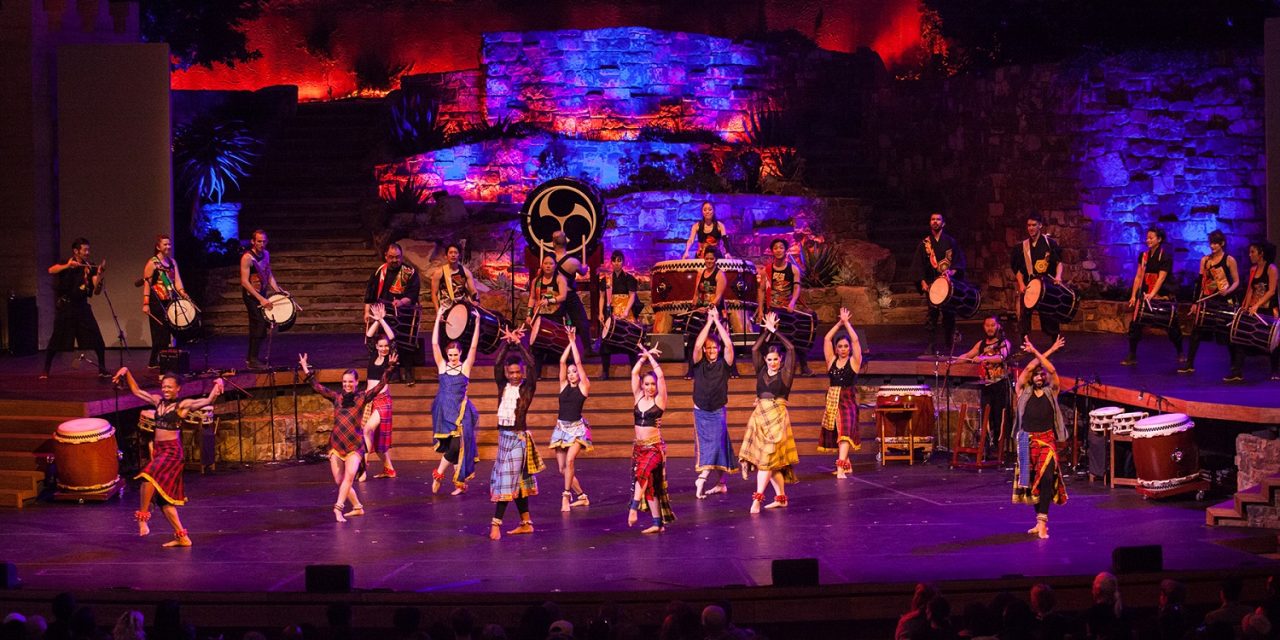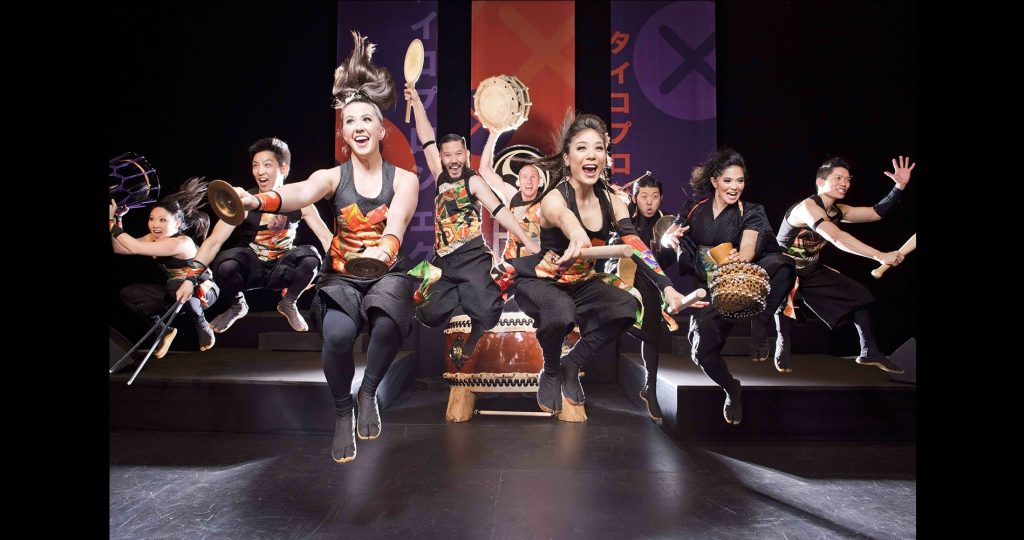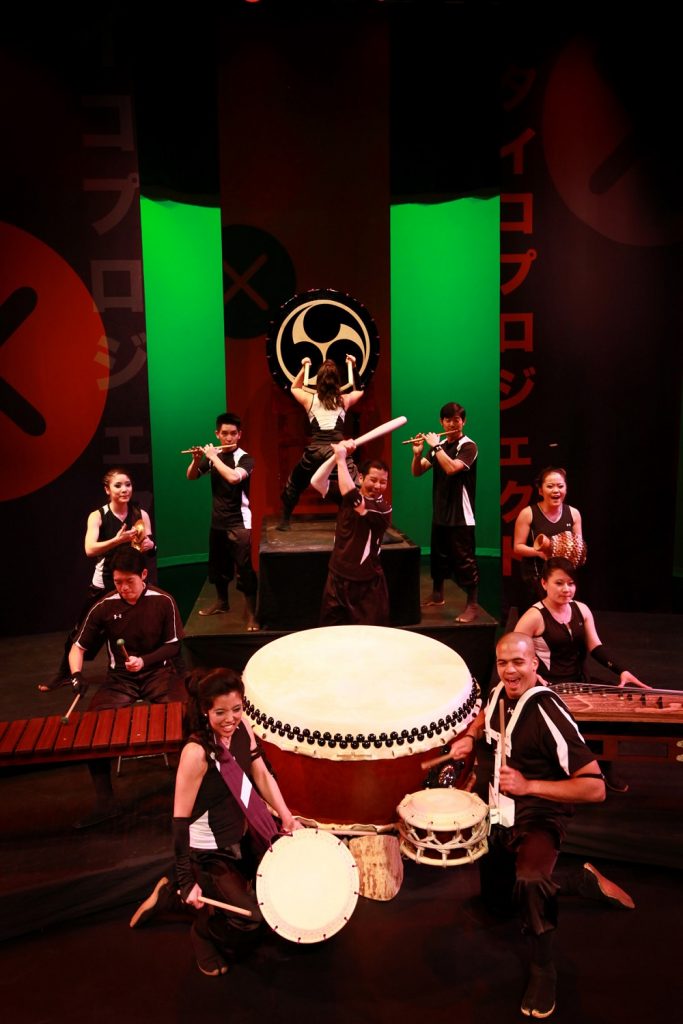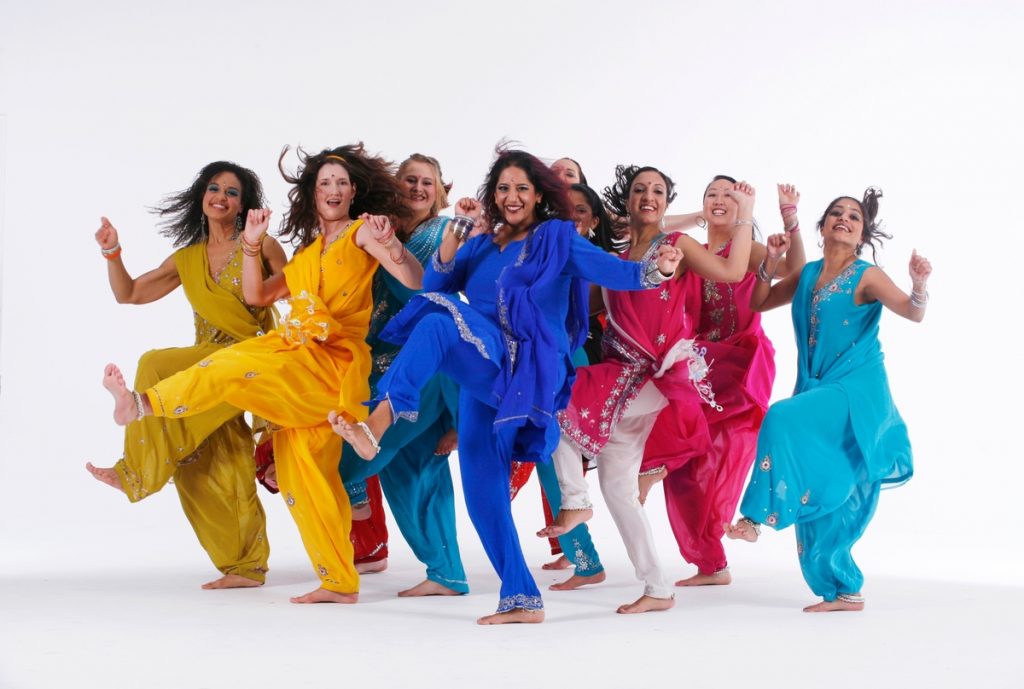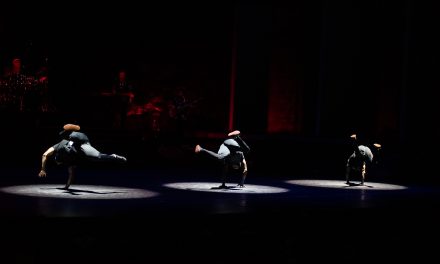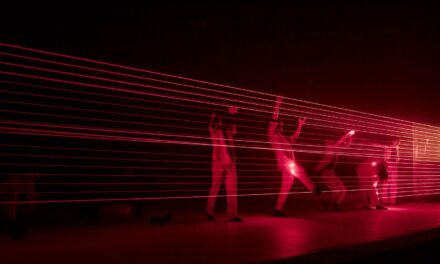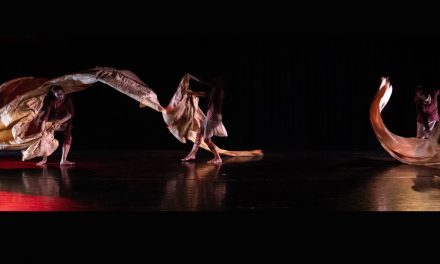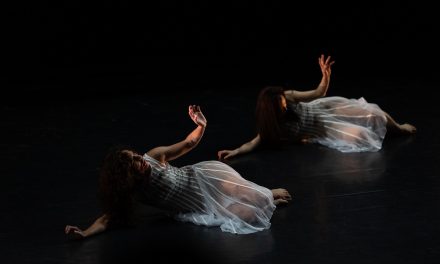This past Saturday, the John Anson Ford Theatres Amphitheatre thundered with the drums of TAIKOPROJECT while blending Japanese rhythms and cultures with the Bollywood style of Blue 13 Dance Company. It was also a chance to see and hear the talented Kitsune Taiko, students of taiko at the TAIKOPROJECT Academy located in LA’s Little Tokyo. This youth group was founded in 2002 and got its name from the “mysterious and mischievous kitsune fox of Japanese folklore”. The Artistic Director of TAIKOPROJECT, Masato Baba, brought these two companies together to create Rhythmic Relations 2018.
According to Wikipedia, “Taiko are a broad range of Japanese percussion instruments. In Japanese, the term refers to any kind of drum, but outside Japan, it is used to refer to any of the various Japanese drums called wadaiko.” In Japanese folklore, taiko is said to have a mythological origin, but history states that taiko were brought to Japan around the 6th century by the Chinese and Koreans during the Kofun period. Others say that taiko resemble instruments used in India during that same time.
Whatever the origins, these drums as played by the TAIKOPROJECT musicians ring of ancient times fused with the rhythms of a modern era. The company musicians were incredible movers as well. The choreography of their arms, legs and entire bodies was interwoven with the music and integral to their performance. The musicians turned, revolved around other drummers and at one time, cartwheeled in-between musical measures. It was astounding to watch and to note that they never missed a beat, and only once during the performance did I see a musician lose one of his/her sticks.
Achinta S. McDaniel is the Artistic Director of Blue 13 Dance Company. Her very talented dancers must be trained in ballet, jazz, tap, modern, and hip hop which McDaniel draws from and combines them with her training in the Indian dance forms Bhangra, Kathak. All this makes up what is now known as Bollywood as seen on television in shows like Sense 8 or in movies such as Slumdog Millionaire. McDaniel’s work is creative, inventive and highly entertaining. She has managed to create a beautiful mixture of two dance genres, the commercial and the concert stage.
The first Act of Rhythmic Relations 2018 featured the TAIKOPROJECT musicians and their students. Between each musical work there were beautiful, sometimes haunting musical interludes that often flowed seamlessly into the next piece. Composed by Bryan Yamami and Masato Baba, Here We Go Now!! introduced everyone, beginning with the younger players. It was very lively and constantly moved the musicians, who were playing on sling drums, around the stage. This was my first time seeing TAIKOPROJECT and will admit that I was pleasantly surprised to see that at least half, if not more, of the musicians were women.
The Japanese instruments included taiko, bamboo flutes (shinobue), marimba and voice. I also saw a Japanese string instrument called a koto, which produced an beautiful ethereal sound. Because I write about dance and not music, I will focus this review on the movement of the TAIKOPROJECT, which was extensive and often breathtaking and the performances of Blue 13 Dance Company.
TSUKI E by Masato Baba was choreographed by Yumi Saito, featured a very large drum, flutes and cymbals. There was a flowing arm dance, introduced by one woman, that grew into a larger group and moved about the lower level of the Ford amphitheater with simple walks, hops, and turns. These musicians, now dancers, glided over the stage as they performed the arm and hand movements that extended like scarfs in a gentle wind outward and overhead. AWAKENING, composed by Andrew Chen, involved the twirling of sticks, positions that resembled Japanese warriors and musicians moving between drums. The music began solemnly with a marimba and built intensity as the drums joined in. TATSUMAKI, which translates as tornado, evoked images of the oncoming of ominous clouds and storm and the twister’s violent arrival. Both student and company members used swirling arm movements as they played drums to soprano voices singing in the background. The work was composed by Hiroshi Tanaka.
A Beautiful flute solo introduced SHOTOTSU, composed by Masato Baba for his wedding in March 2014. Two dancers, one carrying a white umbrella and one a gold fan, represented the union of two families. The bride took the groom’s small gold fan and performed a brief but very lovely Japanese fan dance as he moved about with her umbrella. The exchange of props presented a stylistic exchange of vows and family traditions. RITES OF THUNDERING made use of the largest drums. Through them, one heard and felt the rumblings of an oncoming storm and the crashing of thunder as it passed overhead, eventually dissipating into the distance.
Act One concluded with a work composed by Masato Baba entitled SEIKO which translates as “Success and Celebration”. The program stated that SEIKO “was influenced by Japan’s taiko masters and America’s pioneering taiko groups.” It also said that this performance was the first time both members of TAIKOPROJECT and Kitsune Taiko had performed SEIKO together. There were five double sided drums and the musicians moved about them with turns and large arm movements, all while drumming on the drums, their edges and hitting the sticks together rhythmically. It is a kinetic energy that is difficult to describe in print, but one that must be experienced in person to fully enjoy its brilliance.
Act Two features members of TAIKOPROJECT and members of Blue 13 Dance Company. THE STROLL by composers Bryan Yamami and Masato Baba, began with the musicians seated on the stairs that lead from the upper level up into the hills above the Amphitheatre. As they “strolled” down onto the two leveled stages, Blue 13 dancers leapt, flipped and jumped from offstage to onstage and begin performing with and among the musicians. The movement included obvious references to hip hop, with subtle popping and breaking. The dancers then exited as they entered with leaps and lifts that aided them to disappear into the wings. I was reminded of joyous funeral marches in New Orleans, or participants in a Mardi Gras parade.
SEIZA (constellations) was composed by Masato Baba and Emily Yoshihara, and included the Japanese koto. Two female dancers performed unison movement on both stage levels, on opposite sides of the theater. The movement was very balletic, with slow attitude poses and extensions. As they were joined by a male colleague, the movement fused with a more contemporary modern involving overhead lifts, contractions and wide fourth position Merce Cunningham style torso curves, all the while mixing together Indian and taiko rhythms. This trio was a nice pace shift in the program.
MANY SIDES, composed by Masato Baba, was just the taiko musicians, but there was definite choreography within the performance. Each musician, a la jazz jamming, had a brief solo while spinning, lunging and in one case flipping in place. Both the music and the movement were high energy.
TERPSICHORE IN GHUNGROOS, EXCERPT, began with the Blue 13 dancers hand clapping rhythms in the dark. As the music joined in, three men performed movement that had its roots in jazz dance aligned with East Indian rhythms. The music included songs by several composers and as the piece progressed more dancers joined in with very tense movements and relationships. A troubled romance, a love duet, strange head jerks, hand twitches, and concentrated pauses directed the mood from joyous to dark and somber.
GROUNDED was one of the highlights for me because of the dancing by the TAIKOPROJECT musicians. Six men and women glided over the space with lyrical arm and hand movements, shifting patterns that evoked images of flocks of birds and schools of fish as they coasted and then suddenly changed directions. In a group, their arm gestures and slow foot shifts raised images of Geisha dancers that quietly developed into a social dance with hints of southern square dances or Renaissance dancing. They posed as warriors and skated on ice. It was beautiful.
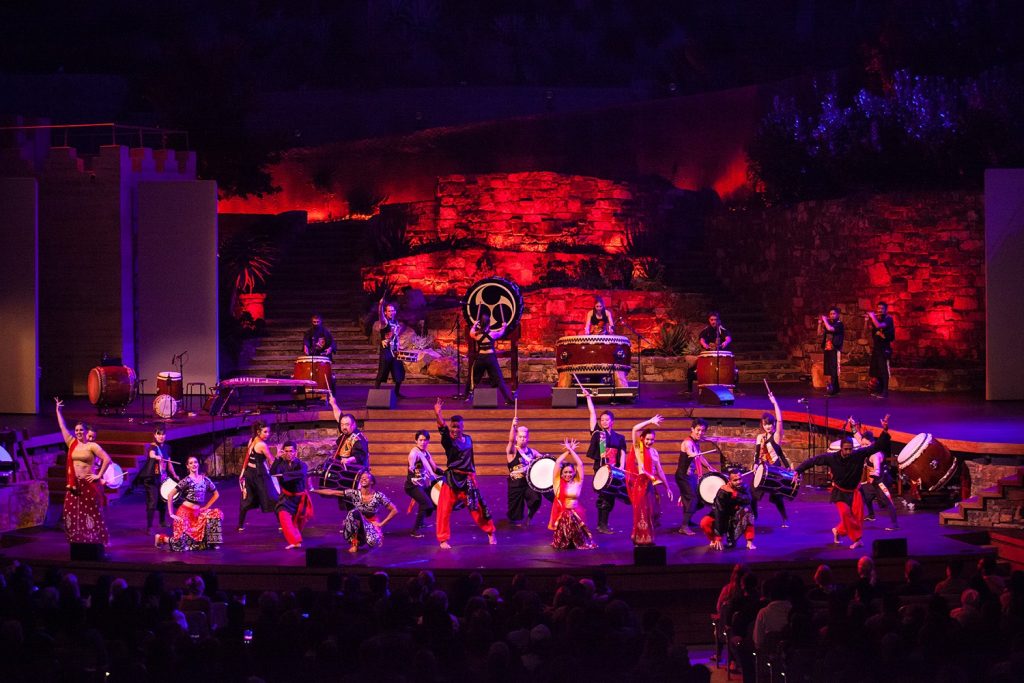
TAIKOPROJECT and Blue 13 Dance Company in Rhythmic Relations 2018 – Photo: Gennia Cui for Ford Theatres
It was difficult to tell where BOLLYWOOD SET ended and SADDA DIL VI TU began, but the dancing definitely had Achinta S. McDaniel’s choreographic stamp on it. This cast was quite amazing in how they shifted and blended all the different dance styles together. Sadly, the music for BOLLYWOOD SET was recorded, giving the feel of dance for TV or film. It was, however, impressive and energetic with balletic turns, jazz style kicks and Indian influenced turns, head and hand movements. The costumes reflected the Bollywood look. Sari style clothes in bright Indian colors and patterns, ankles adorned with bells all mixed together with western style length clothes.
SADDA DIL VI TU, composed by Sachin Jigar, pulled out all the stops. Musicians joined dancers in a high energy, finale style production. The music and the dancing were joyous and celebratory and highlighted the joining of these two cultures.
The final work, EXPANDING, composed by Masato Baba and Bryan Yamami, briefly brought back the youthful Kitsune Taiko. Musicians shifted groups and in one section, used pointing gestures to move the solos from one percussionist to the next. The music got fuller and louder, and if possible more energetic than the piece before it.
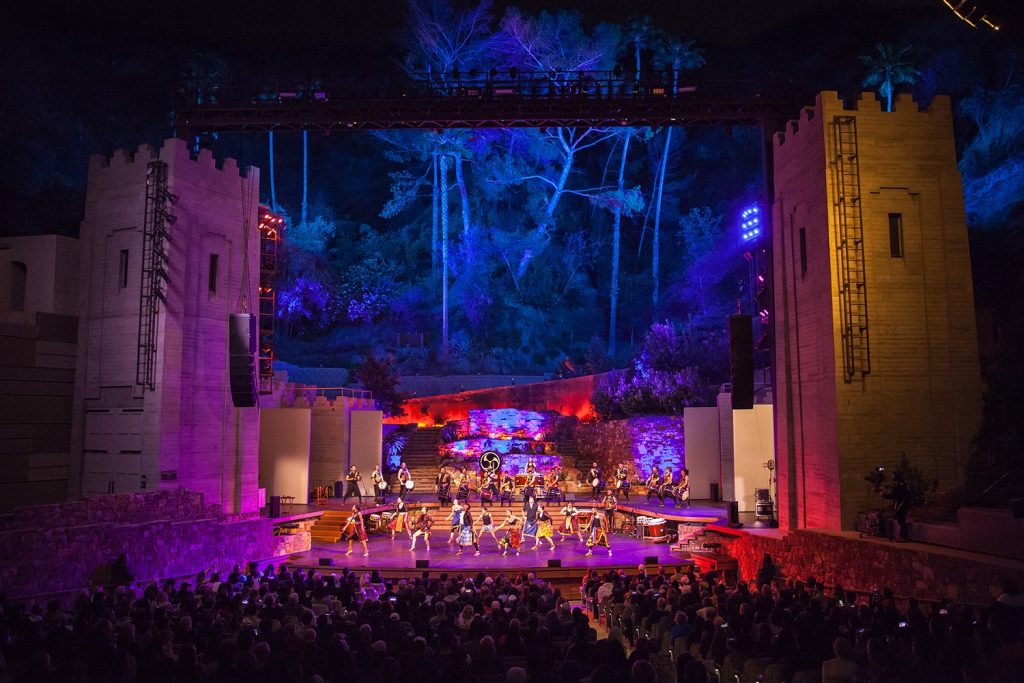
TAIKOPROJECT and Blue 13 Dance Company in Rhythmic Relations 2018 – Photo: Gennia Cui for Ford Theatres
This was an incredible experience of cultures coming together to create a new look and sound, and to see musicians dance with their taiko drums, flutes and cymbals. The Blue 13 dancers that kept drawing my eye was the tall elegant Adrianna Vieux, and the vivacious, technically amazing Shoshana Mozlin.
For more information about TAIKOPROJECT, click here.
For more information about Blue 13 Dance Company, click here.
Featured Photo by Rob Hammer.

